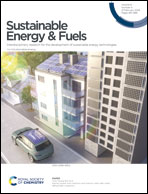Electric power from shadows and indoors: solar cells under diffuse light conditions†
Abstract
As more photovoltaics are installed near urban areas, the light conditions deviate from the standard testing condition (STC) because of the increasing amount of diffuse light induced by scattering or reflection from the surroundings. The omnidirectional nature of diffuse light requires an understanding of the effects of the angle of incidence (AOI) on solar cell performance for the role of diffuse light to be properly analyzed. In this work, experimental measurements and simulations under various circumstances led to the conclusion that the AOI dependence of solar cells is caused by the difference in reflectance. In addition, the wavelength of incident radiation can affect the energy conversion of solar cells, and thus, the AOI effect can be controlled by the surface texture structure and optical layers on the solar cell surface. Using a physical model and assuming that the diffuse light can be treated as a sum of normal distribution functions, we show that each of them represents a diffuse light source by scattering or reflection. We propose a model that combines these to predict the current density under diffuse light; the other solar cell parameters were subsequently obtained from this current density via a two-diode model. The constructed model was applied to photovoltaics deployed in urban environments and indoor applications. The urban application introduces the possibility of enhancing the energy yield through approaches ranging from cell-level control to manipulating the direction of solar modules in the shadow. The indoor photovoltaics can be modeled with various lighting arrays, kinds of lights, and locations of models to deduce the optimal conditions through diffuse-light-effect analysis. In addition, the results indicate that mismatch losses are possible in indoor modules as a result of the geometry of the solar cell module and lighting. Therefore, this analysis can be used as a tool for optimizing the design of indoor solar cells. Despite some limitations, which include the use of a two-dimensional model, a limited number of presented examples, and a possible oversimplification, the proposed model can provide a useful analytical protocol for designing photovoltaics suitable for use in practical locations where, unlike under the STC, diffuse light is abundant.



 Please wait while we load your content...
Please wait while we load your content...